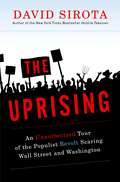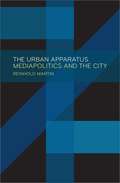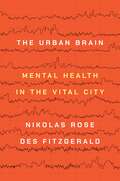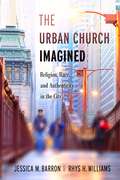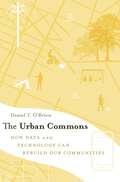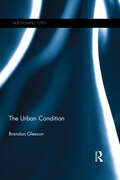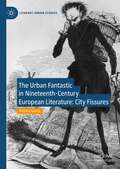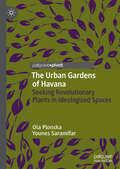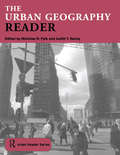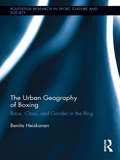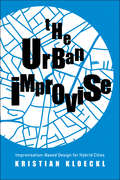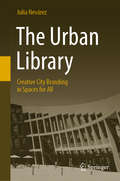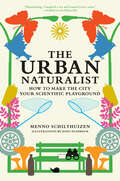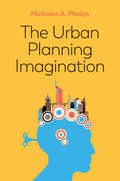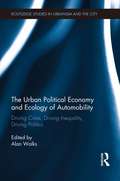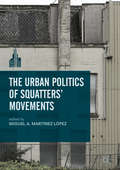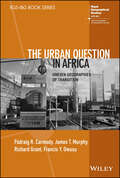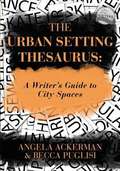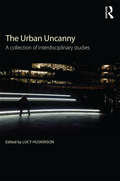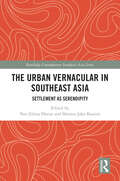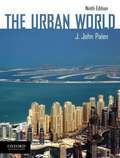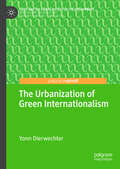- Table View
- List View
The Uprising: An Unauthorized Tour of the Populist Revolt Scaring Wall Street and Washington
by David Sirota[From the book jacket] An All-Access Pass to the Populist Insurrection Brewing Across the Country Job outsourcing. Perpetual busy signals at government agencies. Slashed paychecks. Stolen elections. A war without end, fatally mismanaged. Ordinary Americans on both the Right and Left are tired of being disenfranchised by corrupt politicians of both parties and are organizing to change the status quo. In his invigorating new book, David Sirota investigates whether this uprising can be transformed into a unified, lasting political movement. Throughout the course of American history, uprisings like the one we are seeing now have given birth to powerful movements to end wars, protect workers, and expand civil rights, so the prospect of today's uprising turning into a full- fledged populist movement terrifies Wall Street and Washington. In The Uprising, Sirota takes us far from the national media spotlight into the trenches where real change is happening - from the headquarters of the most powerful third party in America to the bowels of the U.S. Senate; from the auditorium of an ExxonMobil shareholder meeting to the quasi-military staging area of a vigilante force on the Mexican border. This is vital, on-the-ground reporting that immerses us in the tumultuous give-and-take of politics at its most personal. Sirota also offers a biting critique of our politics. He shows how the uprising is, at its core, a reaction to faux "bipartisanship" in the nation's capital - the "bipartisanship" whereby Republican and Democratic lawmakers join together in putting the agenda of corporate interests above all those of ordinary citizens. Ultimately, Sirota reminds us that the Declaration of Independence, "America's original uprising manifesto," says that governments "derive their powers from the consent of the governed." Irreverent and insightful, The Uprising shows how the governed have stopped consenting and have started taking action.
The Urban Apparatus: Mediapolitics and the City
by Reinhold MartinUrbanization is a system of power and knowledge, and today&’s city functions through the expansive material infrastructures of the urban order. In The Urban Apparatus, Reinhold Martin analyzes urbanization and the contemporary city in aesthetic, socioeconomic, and mediapolitical terms. He argues that understanding the city as infrastructure reveals urbanization to be a way of imparting functional, aesthetic, and cognitive order to a contradictory, doubly bound neoliberal regime.Blending critical philosophy, political theory, and media theory, The Urban Apparatus explores how the aesthetics of cities and their political economies overlap. In a series of ten essays, with a detailed theoretical introduction, Martin explores questions related to urban life, drawn from a wide range of global topics—from the fiscal crisis in Detroit to speculative development in Mumbai to the landscape of Mars, from discussions of race and the environment to housing and economic inequality. Each essay proposes a particular &“mediator&” (or a material complex) that is shaped by imaginative practices, each answering the question &“What is a city, today?&” The Urban Apparatus serves as an &“urban&” bookend to the architectural questions explored by Martin in his earlier book Utopia&’s Ghost, and ultimately offers readers a way to think politically about urbanization.
The Urban Brain: Mental Health in the Vital City
by Nikolas Rose Des FitzgeraldBridging the social and life sciences to unlock the mystery of how cities shape mental health and illnessMost of the world’s people now live in cities and millions have moved from the countryside to the rapidly growing megacities of the global south. How does the urban experience shape the mental lives of those living in and moving to cities today? Sociologists study cities as centers of personal progress and social innovation, but also exclusion, racism, and inequality. Psychiatrists try to explain the high rates of mental disorders among urban dwellers, especially migrants. But the split between the social and life sciences has hindered understanding of how urban experience is written into the bodies and brains of urbanites. In The Urban Brain, Nikolas Rose and Des Fitzgerald seek to revive the collaboration between sociology and psychiatry about these critical questions. Reexamining the relationship between the city and the brain, Rose and Fitzgerald explore the ways cities shape the mental health and illness of those who inhabit them.Drawing on the social and life sciences, The Urban Brain takes an ecosocial approach to the vital city, in which humans live and thrive but too often get sick and suffer. The result demonstrates what we can gain by a vitalist approach to the mental lives of those migrating to and living in cities, focusing on the ways that humans make, remake, and inhabit their urban lifeworlds.
The Urban Church Imagined: Religion, Race, and Authenticity in the City
by Rhys H. Williams Jessica M. BarronExplores the role of race and consumer culture in attracting urban congregants to an evangelical church The Urban Church Imagined illuminates the dynamics surrounding white urban evangelical congregations’ approaches to organizational vitality and diversifying membership. Many evangelical churches are moving to urban, downtown areas to build their congregations and attract younger, millennial members. The urban environment fosters two expectations. First, a deep familiarity and reverence for popular consumer culture, and second, the presence of racial diversity. Church leaders use these ideas when they imagine what a “city church” should look like, but they must balance that with what it actually takes to make this happen. In part, racial diversity is seen as key to urban churches presenting themselves as “in touch” and “authentic.” Yet, in an effort to seduce religious consumers, church leaders often and inadvertently end up reproducing racial and economic inequality, an unexpected contradiction to their goal of inclusivity. Drawing on several years of research, Jessica M. Barron and Rhys H. Williams explore the cultural contours of one such church in downtown Chicago. They show that church leaders and congregants’ understandings of the connections between race, consumer culture, and the city is a motivating factor for many members who value interracial interactions as a part of their worship experience. But these explorations often unintentionally exclude members along racial and classed lines. Indeed, religious organizations’ efforts to engage urban environments and foster integrated congregations produce complex and dynamic relationships between their racially diverse memberships and the cultivation of a safe haven in which white, middle-class leaders can feel as though they are being a positive force in the fight for religious vitality and racial diversity. The book adds to the growing constellation of studies on urban religious organizations, as well as emerging scholarship on intersectionality and congregational characteristics in American religious life. In so doing, it offers important insights into racially diverse congregations in urban areas, a growing trend among evangelical churches. This work is an important case study on the challenges faced by modern churches and urban institutions in general.
The Urban Commons: How Data and Technology Can Rebuild Our Communities
by Daniel T. O'BrienThrough voicemail, apps, websites, and Twitter, Boston’s sophisticated 311 system allows citizens to report potholes, broken streetlights, graffiti, and vandalism that affect everyone’s quality of life. Drawing on Boston’s rich data, Daniel T. O’Brien offers a model of what smart technology can do for cities seeking both growth and sustainability.
The Urban Condition (Questioning Cities)
by Brendan GleesonThis book will speak to the new human epoch, the Urban Age. A majority of humanity now lives for the first time in cities. The city, the highest invention of the modern age, is now the human heartland. And yet the same process that brought us the city and its wonders, modernisation, has also thrown up challenges and threats, especially climate change, resource depletion, social division and economic insecurity. This book considers how these threats are encountered and countered in the urban age, focusing on the issue of human knowledge and self-awareness, just as Hannah Arendt’s influential The Human Condition did half a century ago. The Human Condition is now The Urban Condition. And it is this condition that will define human prospects in an age of default and risk. Gleeson expertly explores the concept through three main themes. The first is an exploration of what defines the current human condition, especially the expanding cities that are at the heart of an over-consumptive world economic order. The second exposes and reviews the reawakening of forms of knowledge (‘naturalism’) that are likely to worsen not improve our comprehension of the crisis. The new ‘science of urbanism’ in popular new literature exemplifies this dangerous trend. The third and last part of the book considers prospects for a new urban, and therefore human, dispensation, ‘The Good City’. We must first journey in our urban vessels through troubled times. But can we now start to plot the way to new shores, to a safer, more resilient city that provides for human flourishing? The Urban Condition attempts this ideal, conceiving a new urbanism based on the old idea of self-limitation. The Urban Condition is an original, timely book that reconsiders and redeploys Arendt’s famous notion of The Human Condition in an age of cities and risk. It brings together several important strands of human consideration, urbanisation, climate threat, resource depletion, economic default and critical knowledge and weaves them into a new analysis of the times. It also looks to a future that is nearly with us—of changed climate, resource scarcity and economic stress. The book journeys into these troubled times, proposing the idea of Lifeboat Cities as a way of thinking about the human journey to come
The Urban Fantastic in Nineteenth-Century European Literature: City Fissures (Literary Urban Studies)
by Patricia GarcíaThe Urban Fantastic in Nineteenth-Century European Literature explores transnational perspectives of modern city life in Europe by engaging with the fantastic tropes and metaphors used by writers of short fiction. Focusing on the literary city and literary representations of urban experience throughout the nineteenth century, the works discussed incorporate supernatural occurrences in a European city and the supernatural of these stories stems from and belongs to the city. The argument is structured around three primary themes. “Architectures”, “Encounters” and “Rhythms” make reference to three axes of city life: material space, human encounters, and movement. This thematic approach highlights cultural continuities and thus supports the use of the label of “urban fantastic” within and across the European traditions studied here.
The Urban Gardens of Havana: Seeking Revolutionary Plants in Ideologized Spaces
by Ola Plonska Younes SaramifarThis book relates stories of everyday life revolving around small-scale urban gardens in Central Havana and focusing particularly on that of Marcelo, a seventy-four-year-old revolutionary and gardener. The urban gardens are contested spaces: though monitored and controlled by Cuban state institutions, they also offer possibilities of crafting life in resistance. The experiences the authors narrate are not ‘thick descriptions,’ linked to larger political issues, but rather rhizomatic observations that highlight the relationships between humans and non-humans within the nature-culture debate. Using these experiences, the authors argue that ‘the political’ reaches beyond the affairs of state and governance and should be seen as an all-encompassing part of life. The authors thereby invite the social sciences to focus on the microscopic and the day-to-day to illuminate how the political affairs of lives can be imagined differently.
The Urban Geography Reader (Routledge Urban Reader Series)
by Judith T. Kenny Nicholas R. FyfeDrawing on a rich diversity of theoretical approaches and analytical strategies, urban geographers have been at the forefront of understanding the global and local processes shaping cities, and of making sense of the urban experiences of a wide variety of social groups. Through their links with those working in the fields of urban policy design, urban geographers have also played an important role in the analysis of the economic and social problems confronting cities. Capturing the diversity of scholarship in the field of urban geography, this reader presents a stimulating selection of articles and excerpts by leading figures. Organized around seven themes, it addresses the changing economic, social, cultural, and technological conditions of contemporary urbanization and the range of personal and public responses. It reflects the academic importance of urban geography in terms of both its theoretical and empirical analysis as well as its applied policy relevance, and features extensive editorial input in the form of general, section and individual extract introductions. Bringing together in one volume 'classic' and contemporary pieces of urban geography, studies undertaken in the developed and developing worlds, and examples of theoretical and applied research, it provides in a convenient, student-friendly format, an unparalleled resource for those studying the complex geographies of urban areas.
The Urban Geography of Boxing: Race, Class, and Gender in the Ring (Routledge Research in Sport, Culture and Society)
by Benita HeiskanenThis book is an interdisciplinary cultural examination of twenty-first century boxing as a professional sport, a bodily labor, a lucrative business, a popular entertainment, and an instrument of ideology. Based on ethnographic fieldwork and interviews conducted with Latino boxers, women boxers, and boxing insiders in Texas, it discusses boxing from the vantage point of the sundry players, who are involved with it: the labor force, promoters, handlers, ringside officials, medical professionals, media, and the audiences. The various parties have multiple stakes in the sport. For some, boxing is about physical empowerment; others are in it for the money; some deploy it for ideological purposes; yet others use it to claim their 15-minutes of fame, and frequently the various interests overlap. In this book, Benita Heiskanen makes a broader connection between boxing and the spatial organization of racialized, class-based, and gendered bodies within particular urban geographies. Journeying actual sites where the sport is organized, such as the barrio, boxing gym, and competition venues, she maps the ways in which boxing insiders negotiate a variety of conflicting agendas at local, regional, and national scales. Beyond the United States, the worker-athletes conduct their labor within global socioeconomic conditions, business networks, and legal principles. Through this sporting context, Heiskanen’s discussion discloses some complex socio-historical, cultural, and political power relations between urban margins and centers, with ramifications far beyond boxing. This book will be of interest to readers in Sport Studies, Cultural Studies, Cultural Geography, Gender Studies, Critical Race Theory, Labor Studies, and American Studies.
The Urban Improvise: Improvisation-Based Design for Hybrid Cities
by Kristian KloecklA book for architects, designers, planners, and urbanites that explores how cities can embrace improvisation to improve urban life The built environment in today’s hybrid cities is changing radically. The pervasiveness of networked mobile and embedded devices has transformed a predominantly stable background for human activity into spaces that have a more fluid behavior. Based on their capability to sense, compute, and act in real time, urban spaces have the potential to go beyond planned behaviors and, instead, change and adapt dynamically. These interactions resemble improvisation in the performing arts, and this book offers a new improvisation-based framework for thinking about future cities. Kristian Kloeckl moves beyond the smart city concept by unlocking performativity, and specifically improvisation, as a new design approach and explores how city lights, buses, plazas, and other urban environments are capable of behavior beyond scripts. Drawing on research of digital cities and design theory, he makes improvisation useful and applicable to the condition of today’s technology-imbued cities and proposes a new future for responsive urban design.
The Urban Library: Creative City Branding in Spaces for All
by Julia NevárezThis book examines the role, history and function of public libraries in contemporary societies as motors that drive development. It analyses through case studies, how contemporary libraries have been redesigned to offer a new kind of public space while also reshaping neglected areas in cities. Broadly understood the book seeks to comprehend contemporary library design, urban development and the revitalization of specific urban areas.Important and world famous architects – star-architects – have designed signature architecture in the contemporary libraries selected for this volume. The examples to be showcased in the book include the main Seattle Public Library, Salt Lake City Public Library, New York Public Library, Spain Library Medellin, Colombia, Halifax Central Library Nova Scotia, Canada and Library of Alexandria in Egypt to offer examples of what constitute the approach to libraries and urban development in many cities around the world nowadays. Data in the form of interviews to library directors, librarians and users, tours of libraries, visual documentation and archival research have been collected for most public libraries included as case studies for the book.The impulse to archive has been framed and understood in the literature as a modern desire to control fleeting reality. Libraries as such respond to this desire by collecting, storing and circulating resources (books and other kinds of media). But more recently there has been an emphasis on the public character of library spaces in which people gather not only to obtain information and read by themselves but also to experience the very urban quality of proximity to others in more informal and less structured environments as public space. Community events characterize the programming of all the libraries included in the book. The design of these new libraries fit into urban development initiatives where libraries – like other iconic cultural spaces of cities – become central components to market cities for the consumption of culture. Libraries become sites to be visited and explored by tourists while providing services for residents. They are also machines to accelerate urban development especially in areas previously neglected by development.
The Urban Naturalist: How to Make the City Your Scientific Playground
by Menno SchilthuizenA manifesto—and a field guide—for a new dawn of natural history, practiced by community scientists in their own urban jungle.Imagine taking your smartphone-turned-microscope to an empty lot and discovering a rare mason bee that builds its nest in empty snail shells. Or a miniature spider that hunts ants and carries their corpses around. With a team of citizen scientists, that&’s exactly what Menno Schilthuizen did—one instance in the evolutionary biologist&’s campaign to take natural science to the urban landscape where most of us live today. In this delightful book, The Urban Naturalist, Schilthuizen invites us to join him, to embark on a new age of discovery, venturing out as intrepid explorers of our own urban habitat—and maybe in the process do the natural world some good.Thanks to the open science revolution, real biological discoveries can now be made by anyone right where they live. Schilthuizen shows readers just how to go about making those discoveries, introducing them to the tools of the trade of the urban community scientist, from the tried and tested (the field notebook, the butterfly net, and the hand lens) to the newfangled (internet resources, low-tech gadgets, and off-the-shelf gizmos). But beyond technology, his book holds the promise of reviving the lost tradition of the citizen scientist—rekindling the spirit of the Victorian naturalist for the modern world.At a time when the only nature most people get to see is urban, The Urban Naturalist demonstrates that understanding the novel ecosystems around us is our best hope for appreciating and protecting biodiversity.
The Urban Planning Imagination: A Critical International Introduction
by Nicholas A. PhelpsUrban planning is not just about applying a suite of systematic principles or plotting out pragmatic designs to satisfy the briefs of private developers or public bodies. Planning is also an activity of imagination, with a stock of wisdom and an array of useful methods for making decisions and getting things done. This critical introduction uncovers and celebrates this imagination and its creative potential. Nicholas A. Phelps explores the key themes and driving questions in the circulation of planning ideas and methods over time and across spaces, identifying the contrasts and commonalities between urban planning systems and cultures. He argues that the tools for inclusive urban planning are today, more than ever, not solely restricted to the hands of planning bodies, but are distributed across citizens, a variety of organizations (what Phelps calls ‘clubs’) and states. As a result, the book sets the ground for the new arrangements between these groups and actors which will be central to the future of urban planning. By unsettling standard accounts, this book compels us towards more critical and creative thinking to ensure that the imagination, wisdom and methods of urban planning are mobilized towards achieving the aspiration of shaping better places.
The Urban Political Economy and Ecology of Automobility: Driving Cities, Driving Inequality, Driving Politics (Routledge Studies in Urbanism and the City)
by Alan WalksJust how resilient are our urban societies to social, energy, environmental and/or financial shocks, and how does this vary among cities and nations? Can our cities be made more sustainable, and can environmental, economic and social collapse be staved off through changes in urban form and travel behaviour? How might rising indebtedness and the recent series of financial crises be related to automobile dependence and patterns of urban automobile use? To what extent does the system and economy of automobility factor in the production of urban socio-spatial inequalities, and how might these inequalities in mobility be understood and measured? What can we learn from the politics of mobility and social movements within cities? What is the role of automobility, and auto-dependence, in differentiating groups, both within cities and rural areas, and among transnational migrants moving across international borders? These are just some of the questions this book addresses. This volume provides a holistic and reflexive account of the role played by automobility in producing, reproducing, and differentiating social, economic and political life in the contemporary city, as well as the role played by the city in producing and reproducing auto-mobile inequalities. The first section, titled Driving Vulnerability, deals with issues of global importance related to economic, social, financial, and environmental sustainability and resilience, and socialization. The second section, Driving Inequality, is concerned with understanding the role played by automobility in producing urban socio-spatial inequalities, including those rooted in accessibility to work, migration status and ethnic concentration, and new measures of mobility-based inequality derived from the concept of effective speed. The third section, titled, Driving Politics, explores the politics of mobility in particular places, with an eye to demonstrating both the relevance of the politics of mobility for influencing and reinforcing actually existing neoliberalisms, and the kinds of politics that might allow for reform or restructuring of the auto-mobile city into one that is more socially, politically and environmentally just. In the conclusion to the book Walks draws on the findings of the other chapters to comment on the relationship between automobility, neoliberalism and citizenship, and to lay out strategies for dealing with the urban car system.
The Urban Politics of Squatters' Movements
by Miguel A. Martínez LópezThis volume sheds light on the development of squatting practices and movements in nine European cities (Madrid, Barcelona, Seville, Rome, Paris, Berlin, Copenhagen, Rotterdam and Brighton) by examining the numbers, variations and significant contexts in their life course. It reveals how and why squatting practices have shifted and to what extent they engender urban movements. The book measures the volume and changes in squatting over various decades, mostly by focusing on Squatted Social Centres but also including squatted housing. In addition, it systematically compares the cycles, socio-spatial structures and the political implications of squatting in selected cities. This collection highlights how squatters’ movements have persisted over more than four decades through different trajectories and circumstances, especially in relation to broader protest cycles and reveals how political opportunities and constraints influence the conflicts around the legalisation of squats.p>
The Urban Question in Africa: Uneven Geographies of Transition (RGS-IBG Book Series)
by Richard Grant James T. Murphy Padraig R. Carmody Francis Y. OwusuIlluminates the path to more generative urban transitions in Africa's cities and developing rural areas Africa is the world's most rapidly urbanizing region. The predominantly rural continent is currently undergoing an “urban revolution” unlike any other, generally taking place without industrialization and often characterized by polarization, poverty, and fragmentation. While many cities have experienced construction booms and real estate speculation, others are marked by expanding informal economies and imploding infrastructures. The Urban Question in Africa: Uneven Geographies of Transition examines the imbalanced and contested nature of the ongoing urban transition of Africa. Edited and authored by leading experts on the subject, this unique volume develops an original theory conceptualizing cities as sociotechnical systems constituted by production, consumption, and infrastructure regimes. Throughout the book, in-depth chapters address the impacts of current meta-trends—global geopolitical shifts, economic changes, the climate crisis, and others—on Africa's cities and the broader development of the continent. Presents a novel framework based on extensive fieldwork in multiple countries and regions of the continent Examines geopolitical and socioeconomic topics such as manufacturing in African cities, the green economy in Africa, and the impact of China on urban Africa Discusses the prospects for generative urbanism to produce and sustain long-term development in Africa Features high-quality maps, illustrations, and photographsThe Urban Question in Africa: Uneven Geographies of Transition is essential reading for undergraduate and postgraduate students in geography, urban planning, and African studies, academic researchers, geographers, urban planners, and policymakers.
The Urban Revolution
by Henri LefebvreOriginally published in 1970, The Urban Revolution marked Henri Lefebvre’s first sustained critique of urban society, a work in which he pioneered the use of semiotic, structuralist, and poststructuralist methodologies in analyzing the development of the urban environment. Although it is widely considered a foundational book in contemporary thinking about the city, The Urban Revolution has never been translated into English—until now. This first English edition, deftly translated by Robert Bononno, makes available to a broad audience Lefebvre’s sophisticated insights into the urban dimensions of modern life.Lefebvre begins with the premise that the total urbanization of society is an inevitable process that demands of its critics new interpretive and perceptual approaches that recognize the urban as a complex field of inquiry. Dismissive of cold, modernist visions of the city, particularly those embodied by rationalist architects and urban planners like Le Corbusier, Lefebvre instead articulates the lived experiences of individual inhabitants of the city. In contrast to the ideology of urbanism and its reliance on commodification and bureaucratization—the capitalist logic of market and state—Lefebvre conceives of an urban utopia characterized by self-determination, individual creativity, and authentic social relationships.A brilliantly conceived and theoretically rigorous investigation into the realities and possibilities of urban space, The Urban Revolution remains an essential analysis of and guide to the nature of the city.Henri Lefebvre (d. 1991) was one of the most significant European thinkers of the twentieth century. His many books include The Production of Space (1991), Everyday Life in the Modern World (1994), Introduction to Modernity (1995), and Writings on Cities (1995).Robert Bononno is a full-time translator who lives in New York. His recent translations include The Singular Objects of Architecture by Jean Baudrillard and Jean Nouvel (Minnesota, 2002) and Cyberculture by Pierre Lévy (Minnesota, 2001).
The Urban Setting Thesaurus: A Writer's Guide to City Spaces
by Angela Ackerman; Becca PuglisiMaking readers care and feel like they’re part of the story should be the number one goal for all writers. Ironically, many storytellers fail to maximize one of fiction’s most powerful elements to achieve this: the setting. Not only can the right location become a conduit for emotion, it can also provide conflict, characterize the story’s cast, reveal significant backstory, and trigger the reader’s own emotional memories through sensory details and deep point of view.
The Urban Uncanny: A collection of interdisciplinary studies
by Lucy HuskinsonThe Urban Uncanny explores through ten engaging essays the slippage or mismatch between our expectations of the city—as the organised and familiar environments in which citizens live, work, and go about their lives—and the often surprising and unsettling experiences it evokes. The city is uncanny when it reveals itself in new and unexpected light; when its streets, buildings, and people suddenly appear strange, out of place, and not quite right. Bringing together a variety of approaches, including psychoanalysis, historical and contemporary case study of cities, urban geography, film and literary critique, the essays explore some of the unsettling mismatches between city and citizen in order to make sense of each, and to gauge the wellbeing of city life more generally. Essays examine a number of cities, including Edmonton, London, Paris, Oxford, Las Vegas, Berlin and New York, and address a range of issues, including those of memory, death, anxiety, alienation, and identity. Delving into the complex repercussions of contemporary mass urban development, The Urban Uncanny opens up the pathological side of cities, both real and imaginary. This interdisciplinary collection provides unparalleled insights into the urban uncanny that will be of interest to academics and students of urban studies, urban geography, psychoanalysis, cultural studies, social studies and film studies, and to anyone interested in the darker side of city life.
The Urban Vernacular in Southeast Asia: Settlement as Serendipity (Routledge Contemporary Southeast Asia Series)
by Nor Zalina Harun and Shireen Jahn KassimThis book constructs a number of discourses, dialectics and analyses across the disciplines of urban form, architecture and urban experience, thus incorporating both conservation and design issues.It bridges the gap between practice and theory by reconstructing the role of the “village” or “vernacular” in the discourses and trends of the twenty-first century post-Covid19 environment. Bringing together for the first time the confluences of theory and practice in the “urban vernacular” and the “urban village,” the contributors use vernacular concepts and settings as a common framework serving as cultural bridges, connecting traditional forms, ecologies and habitats to new global ideas, industrial economies and access to developing urban sustainability, design, planning and services in Asia's rising megacities. The book begins with concerns of urban layout and morphology, aiming to establish discourse, shared principles and terminology around conventional ideas of the “village” or traditional settlements' apparently organic and disordered nature. It then moves into architectural dimensions, capturing formal cases of how the “vernacular” or traditional “indigenous” local concepts have inspired new ideas in award-winning architecture and hence the importance of re-examining the vernacular in light of the ongoing need to produce a more sustainable and place-conscious fit in modern architecture and urban planning.The book will be of interest to researchers in the fields of architecture, urban planning and design, urban geography, design studies, landscape architecture, history of architecture/urbanism and Asian Studies, in particular those concerning Southeast Asia.
The Urban World (Ninth Edition)
by J. John PalenThe Urban World provides a comprehensive, balanced, up-to-date, cross-cultural look at cities and suburbs around the world. Offering a 21st century view of the changing urban scene, the text covers evolving urban patterns and the changing nature of urban life.
The Urbanisation of Rome and Latium Vetus
by Francesca FulminanteThis book focuses on urbanization and state formation in middle Tyrrhenian Italy during the first millennium BC by analyzing settlement organization and territorial patterns in Rome and Latium vetus from the Bronze Age to the Archaic Era. In contrast with the traditional diffusionist view, which holds that the idea of the city was introduced to the West via Greek and Phoenician colonists from the more developed Near East, this book demonstrates important local developments towards higher complexity, dating to at least the beginning of the Early Iron Age, if not earlier. By adopting a multidisciplinary and multi-theoretical framework, this book overcomes the old debate between exogenous and endogenous by suggesting a network approach that sees Mediterranean urbanization as the product of reciprocal catalyzing actions.
The Urbanism of Exception
by Martin J. MurrayThis book challenges the conventional (modernist-inspired) understanding of urbanization as a universal process tied to the ideal-typical model of the modern metropolis with its origins in the grand Western experience of city-building. At the start of the twenty-first century, the familiar idea of the 'city' - or 'urbanism' as we know it - has experienced such profound mutations in both structure and form that the customary epistemological categories and prevailing conceptual frameworks that predominate in conventional urban theory are no longer capable of explaining the evolving patterns of city-making. Global urbanism has increasingly taken shape as vast, distended city-regions, where urbanizing landscapes are increasingly fragmented into discontinuous assemblages of enclosed enclaves characterized by global connectivity and concentrated wealth, on the one side, and distressed zones of neglect and impoverishment, on the other. These emergent patterns of what might be called enclave urbanism have gone hand-in-hand with the new modes of urban governance, where the crystallization of privatized regulatory regimes has effectively shielded wealthy enclaves from public oversight and interference.
The Urbanization of Green Internationalism (Cities and the Global Politics of the Environment)
by Yonn DierwechterThe recent rise of cities in global environmental politics has stimulated remarkable debates about sustainable urban development and the geopolitics of a changing world order no longer defined by tightly bordered national regimes. This book explores this major theme by drawing on approaches that document the diverse histories and emergent geographies of “internationalism.” It is no longer possible, the book argues, to analyze the global politics of the environment without considering its various urbanization(s), wherein multiple actors are reforming, reassembling and adapting to nascent threats posed by global ecological decay. The ongoing imposition and abrasion of different world orders—Westphalian and post-Westphalian—further suggests we need a wider frame to capture new kinds of urbanized spaces and global green politics. The book will appeal to students, scholars, and practitioners interested in global sustainability, urban development, planning, politics, and international affairs. Case studies and grounded examples of green internationalism in urban action ultimately explore how select city-regions like Cape Town, Los Angeles, and Melbourne are trying to negotiate and actually work through this postulated dilemma.
